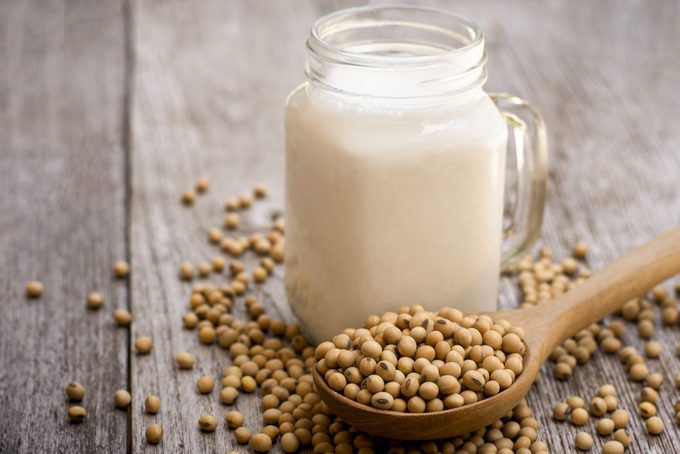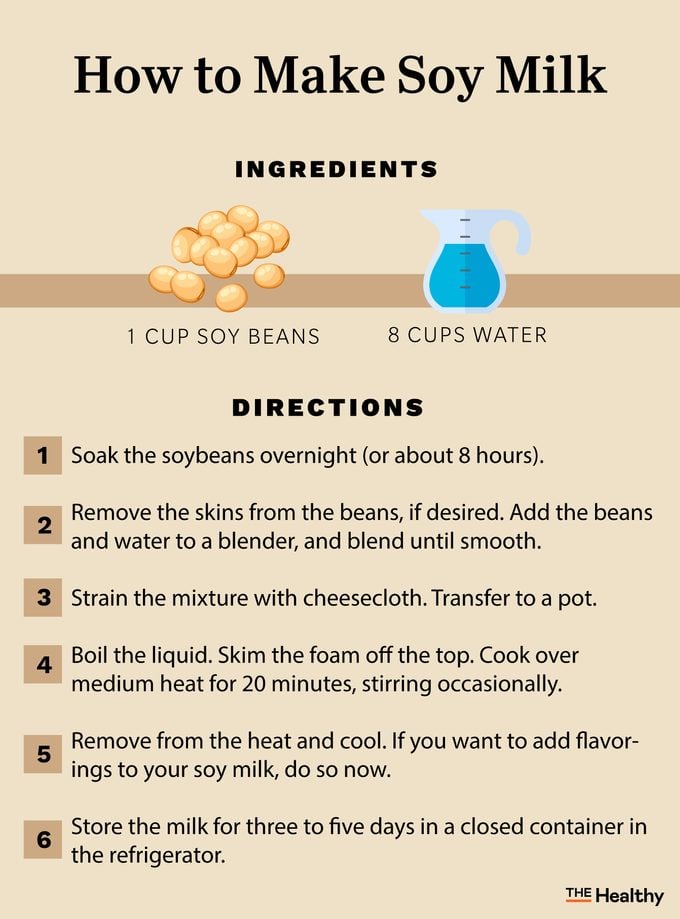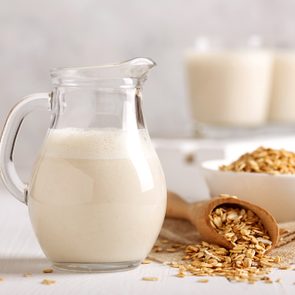Is Soy Milk Good for You?
Updated: Mar. 16, 2022
Learn more about soy milk's benefits and nutrition, including its carbs, calories, and protein. Added bonus? Find out how to make soy milk at home using an easy recipe.
The popularity of soy milk
Shopping carts are filling with plant-based milks of all kind, from oat milk to rice milk and everything in between.
But even with a surge of new plant-based milks, soy milk has remained one of the most popular. And it doesn’t look like it’s going anywhere. Forecasters predict soy milk’s worldwide market value will reach about $23.2 billion dollars in 2025, a dramatic increase from its $15.33 billion dollar market value in 2018, according to a trend report by Statista.
Consumers reach for soy milk for a variety of reasons. But how does it really compare to dairy milk and other plant-based alternatives? And can soy milk be bad for you?
Here’s everything you need to know about soy milk nutrition and benefits.
How is soy milk made?
Soy milk is made from soybeans. The beans are soaked, ground up, and then boiled down into a liquid, which is then filtered to remove any remaining particles. The result: a smooth and creamy product that resembles milk.
Soy milk is often packed just like that, though some brands (and home cooks) add flavorings and sweeteners to create the desired taste.
Commercial soy milk is typically fortified with key nutrients, such as vitamin A and vitamin D. Homemade soy milk, on the other hand, is rarely fortified.
Soy milk nutrition
One cup (244 grams) of unsweetened soy milk contains the following nutrients:
Calories: 105
Protein: 6.3 g (13 percent of the daily recommended value, or DV)
Fat: 3.6 g (5 percent DV)
Sodium: 115 mg (5 percent DV)
Carbohydrates: 12 g (4 percent DV)
Fiber: 0.4 g (2 percent DV)
Vitamin D: 2.7 ug (13 percent)
Calcium: 300 mg (23 percent DV)
Iron: 1 mg (6 percent DV)
Potassium: 298 mg (6 percent DV)

How does soy milk compare to other plant-based milks?
Based on nutritional value alone, soy milk beats out other plant-based milks.
“Soy milk is the most similar of plant-based milks to low-fat cow’s milk when looking at overall calories, protein, and vitamin and mineral content like calcium and vitamin D when fortified,” explains Kathleen Oswalt, RDN, owner of Eat, Love, Triathlon, a coaching service that helps athletes use plant-based eating to improve performance.
Fortified soy milk can help you meet your vitamin B12 requirements, Oswalt says. That’s good news for people following a vegan meal plan, which often lacks this key nutrient.
But where soy milk really shines is in its protein content.
“Other plant-based milks lack protein, whereas soy milk is a plant-based protein powerhouse, providing 7 grams of protein per cup,” says Kelsey Lorencz, a registered dietitian at Graciously Nourished.
It’s not just the amount of protein that makes soy milk nutritionally superior. It’s the quality too. Soy is a complete protein. “Unlike other plant-based milks, soy milk contains all nine essential amino acids,” says Oswalt. The body needs these to synthesize its own protein supply.
(Here’s a side-by-side comparison of soy milk vs. almond milk.)
Soy milk benefits
Soy milk provides the diet with a source of plant-based protein, but its benefits don’t stop there.
“Incorporating approximately two glasses of soy milk into your daily diet may have beneficial heart health effects,” says Oswalt.
A meta-analysis published in 2019 in The Journal of Nutrition found that adding soy protein to the diet may help to reduce levels of total cholesterol as well as unhealthy LDL cholesterol.
For people with type 2 diabetes, adding soy milk can offer additional benefits. A review of research published in 2016 in the Yonsei Medical Journal indicates that soy protein may improve both blood sugar levels and insulin resistance.
Is soy milk bad for you?
Although adding a plant-based milk such as soy milk to your diet can offer many health benefits, there is one big downside:
“Soy is one of the Big Eight allergens, meaning there’s a large group of people who can’t drink soy milk,” says Lorencz. The other most common foods allergens are dairy milk, eggs, tree nuts, peanuts, shellfish, wheat, and fish.
If you do have a soy allergy, all is not lost. Although you will need to avoid all soy in the diet (including soy milk), you can still enjoy plant-based milk. If allergies prevent you from enjoying soy milk, try rice milk, oat milk, or cashew milk instead.
As for another downside you may have heard about—soy’s link to breast cancer—let us dispel the myth right now. Although soy isoflavones can act like estrogens, they don’t cause breast cancer in humans. Some animal studies published in the ’90s suggested a link between soy and breast cancer, but research since then has found no link in humans.
How to choose the best soy milk
Not every soy milk is created equal. To choose the most nutritious option, pay attention to the nutrition label and ingredient list.
“Soy milk, just like other plant-based milks, can include a lot of added sugars, so be sure to look for an unsweetened variety,” says Lorencz. The word “unsweetened” on the package makes that easy.
Other ways to make sure you’re drinking a lower-sugar variety: Don’t buy soy milk that lists sources of added sugar in the top three ingredients. And choose varieties that include as few grams of added sugar as possible.
Keep an eye on the vitamin and mineral content too. “Make sure the soy milk you choose is fortified with vitamins and minerals, like calcium, vitamin D, and vitamin B12,” says Oswalt.
How to use soy milk
Like any other type of milk, soy milk’s uses are endless. You can drink it by the glass, pour it over cereal, and cook with it as you would cow’s milk. Here’s how to substitute soy milk for dairy milk in recipes.
How to make soy milk at home

Sure, you can buy a carton of soy milk in stores. But if you want more control over the ingredients you use, want to limit the amount of added sugar, or just love cooking, you can make your own at home.
Thankfully, it’s an easy task. Here’s how to do it:
An Easy, Homemade Soy Milk Recipe
Ingredients
1 cup soybeans
8 cups water
Directions
- Soak the soybeans overnight (or for about 8 hours).
- After soaking, removing the skins from the beans, if desired. Add the beans and water to a high-powered blender, and blend thoroughly until smooth.
- Strain the mixture using a cheesecloth, then transfer into a pot.
- Bring the liquid to a boil. Skim the foam off the top. Cook over medium heat for 20 minutes, stirring occasionally.
- Remove from the heat and allow liquid to cool. If you want to add flavorings to your soy milk, do so now.
- Store the milk for three to five days in a closed container in the refrigerator.





















